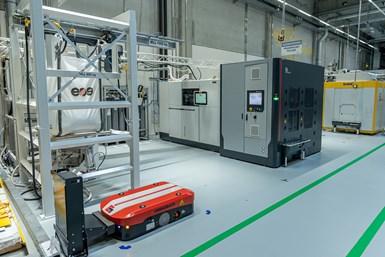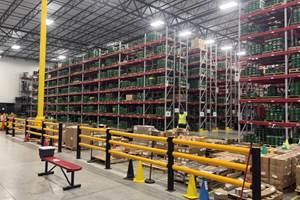Consortium Successfully Implements Automated AM Production Line at BMW Group
After a three-year project time line, the Polyline project was finally completed with a fully automated operation installed at BMW’s additive manufacturing campus in Munich, Germany.
Team members of the Polyline project say they have achieved the first successful implementation of an automated additive manufacturing (AM) production line for polymer parts at scale. At the Additive Manufacturing Campus of BMW in Munich, Germany, the project partners say they made real 3D printing serial production with high throughput a reality. BMW, DyeMansion, EOS and Grenzebach — four partners of the consortium — are pleased with the results.
“The successful Polyline project shows that an end-to-end automated factory is possible with 3D printing — and this is just the beginning,” says Philipp Kramer, DyeMansion CTO and co-founder.
Dr. Blanka Szost-Ouk, head of Additive Manufacturing, Predevelopment and Planning at BMW Group concurs. “The Polyline automated process chain fits into the next-generation printers and our standard production requirements, is a system-agnostic solution due to their standardized interfaces. Which is crucial for scaling up Additive Manufacturing,” Szost-OuK says.
The Polyline project brought together 15 industrial and research partners from Germany to develop a next-generation digitalized production line. The line has been used to produce plastic parts for the automotive industry. The aim was to complement conventional production techniques (such as machining, casting and more) with AM in the form of high-throughput production line systems. The project was funded by the German Federal Ministry of Education and Research and had a defined duration of three years.
Polyline project partners include BMW, DyeMansion, EOS, Grenzebach, Krumm e.K., 3yourmind, Optris, Additive Marking, Olschner, Uni Paderborn, Uni Duisburg-Essen, Uni Dortmund, Fraunhofer IGCV, Universität Augsburg and Fraunhofer IML. Associated partners include WAZP, STIHL, Protiq, GS1 Germany, Oechsler, ZF, Main Incubator, TOPTICA, Prototal, 1zu1.
Fabian Krauß, EOS head of Polymer Systems, is looking to the future after this success. “We have developed this at BMW for the automotive industry and we can now adopt and adjust it to other industries,” Krauß says.
According to Oliver Elbert, head of Additive Manufacturing at Grenzebach, the main advantages of automation are to increase the productivity of the equipment, reduce the downtime of the equipment and create a safe work environment for the employees,
How the AM Lighthouse Project Worked
Automotive manufacturer BMW has given the project a home in its Additive Manufacturing Campus in Munich and has taken over the coordination of the different project partners. EOS was responsible for the printing with its EOS P 500, which can be fully automated and fully integrated. The level of automation and integration can be adjusted specifically to each situation. The machine is designed to ensure reliability and homogeneity, as well as repeatability and reproducibility.
As a specialist in the automation of industrial processes, Grenzebach contributed its expertise in the intelligent and safe networking of manufacturing processes to the project. This includes the Exchange P500/4 solution, which is placed directly at the printer and automatically replaces the exchange frame and cools the build jobs in the buffer stations. It includes automated transport of the exchange frame to the next stations with the secure transport container and an automated guided vehicle (AGV). It also features a robotic cell with KLT handling and bin-picking robots for further processing and sorting of components. In addition, the joint development of automated hardware and software interfaces suitable for industrial use in all process stations was a central component of the Grenzebach work package.
DyeMansion, a provider of postprocessing solutions for industrial polymer 3D printing, was responsible for delivering the right look and feel for the final application, including all areas of postprocessing (cleaning, surfacing and coloring). It is said DyeMansion’s processes are completely traceable, ensuring consistent quality. The Powershot Dual Performance fulfills all requirements for physical automation, so it can run batch after batch continuously without the need for an operator to be present.
Together with all other project partners and thanks to the funding by the German Federal Ministry of Education and Research, BMW, DyeMansion, EOS and Grenzebach developed a next-generation digitalized production line.
“The Polyline automated process chain fits into the next-generation printers and our standard production requirements, is a system-agnostic solution due to their standardized interfaces, which is crucial for scaling up Additive Manufacturing at the BMW Group,” Szost-Ouk says.
DyeMansion notes the importance of automation. “Automation is one of the key drivers in our strategy, making it possible to integrate our systems in automated production lines like Polyline,” Kramer says. “And this is important to reduce cost per part and ensure the right quality throughout the whole production chain.”
Enabling serial manufacturing is one of the main reasons why DyeMansion was founded. “The Powershot Dual Performance was built for scale, so it can serve 10 or even more printers in production and therefore make an end-to-end factory possible,” Kramer adds. “The main takeaway here is that an end-to-end automated factory is possible with 3D printing. The successful Polyline project shows what's possible and this is just the beginning.”
Krauß talks about EOS’ part in the project. “The EOS P 500 … can be fully automated and fully integrated,” Krauß says. “The machine ensures the highest reliability, the highest level of homogeneity, repeatability and reproducibility.”
The EOS P 500 also provides a flexibility, offering different modes of operation and a one-click mode of operation for shop floor execution as well as an all-access operation for manufacturing engineers. “Using industry-standard APIs for software connectivity, hardware automation and integration, the EOS P500 can be integrated into industrial environments,” Krauß adds.
According to Grenzebach, the aim of the Polyline project was to develop a fully automated selective laser sintering production line. “As an automation company, our part was to develop the layout of the line, provide the automation equipment for the transport between the different machines, and create the machine interfaces together for our project partners,” Elbert says. “The main advantages of automation are to increase the productivity of the equipment, to reduce the downtime of the equipment, and to create a safe work environment for the employees. Automation is essential for serial production to increase the productivity of the equipment and to reduce the cost to become more compatible to the conventional production technology of today.”
- Learn about Grenzebach developing an automated depowdering system for SLM Solutions. The DPS NXG enables automated depowdering of 3D components up to 2.3 tons.
- Here’s more information on how Grenzebach aids optimal material flow. With custom-fit transport and handling technology, Grenzebach solutions ensure an optimal material flow. Printers, saws, eroding machines, furnaces and finishing systems are smoothly integrated and linked.
Related Content
How Additive Manufacturing Is Transforming EVs and Transportation: AM Radio #23
As 3D printing is adopted into the electric vehicle (EV) market, it is not just vehicles that are being reshaped. In this episode of the AM Radio podcast, we discuss additive manufacturing and the future of transportation.
Read MoreMultimaterial 3D Printing Enables Solid State Batteries
By combining different 3D printing processes and materials in a single layer, Sakuu’s Kavian platform can produce batteries for electric vehicles and other applications with twice the energy density and greater safety than traditional lithium-ion solutions.
Read MoreHow AM Enables Cobot Automation for Thyssenkrupp Bilstein (Includes Video)
The shock absorber maker has responded to its staffing shortages through extensive use of collaborative robots. In-house 3D printing makes this possible by providing the related hardware needed to complete the cobot-automated cells.
Read MoreDo Distributors Dream of Digital Inventory? Würth Additive Group Does
It’s more than a dream for Würth Additive Group and its parent company, in fact. Along with supplying additive equipment, the group is now developing solutions for sourcing 3D printed parts in a reliable, elastic digital inventory model.
Read MoreRead Next
Hybrid Additive Manufacturing Machine Tools Continue to Make Gains (Includes Video)
The hybrid machine tool is an idea that continues to advance. Two important developments of recent years expand the possibilities for this platform.
Read More3D Printing Brings Sustainability, Accessibility to Glass Manufacturing
Australian startup Maple Glass Printing has developed a process for extruding glass into artwork, lab implements and architectural elements. Along the way, the company has also found more efficient ways of recycling this material.
Read More4 Ways the Education and Training Challenge Is Different for Additive Manufacturing
The advance of additive manufacturing means we need more professionals educated in AM technology.
Read More






















